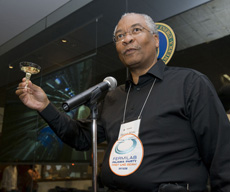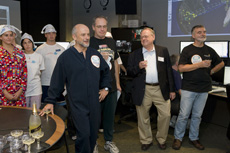Fermilab crowd joins CERN live to celebrate LHC startup
 |
| LHC first beam Pajama Party emcee Herman White toasts the start up of the LHC. |
Roughly 400 people gave up sleep early Wednesday to become part of history and watch the launch of the high-energy physics machine expected to change our knowledge of the universe.
Addressing the Fermilab crowd via video conference, CERN Director General Robert Aymar thanked the people at Fermilab for their help over the years.
The U.S. contributed $531 million to the LHC construction and hosts about 2,000 of the 6,000 scientists worldwide working on the LHC experiments. About 100 U.S. universities contribute to the LHC experiments, including hardware, computing and data analysis.
Aymar praised the Japanese-and American-made equipment that, he said, worked without difficulty on the first 17-mile clockwise trip of the beam of the Large Hadron Collider at CERN.
 |
| Dressed in a pajama, Fermilab Director Pier Oddone (center) spoke via videoconference to scientists at CERN during the LHC startup celebration. QuarkNet students from several states as well as Mike Procario, DOE, Jim Reidy, NSF, and Harry Weerts, Argonne, joined in. |
In less than an hour, a team of accelerator experts managed to send the first beam all the way around the 17-mile LHC ring.
During the three-hour pajama party held at Fermilab, few people ever sat down. They stayed glued to the live television video feed of the beam's progress around the LHC ring. The crowd of scientists, journalists, elected officials and science fans gathered at 1:30 a.m., many in robes, slippers and footy pajamas, to listen intently to speeches by members of the CMS and ATLAS collaborations as well as U.S. science funding agencies and leaders of DESY, KEK, Fermilab and CERN. Representatives of DOE and NSF reiterated their long-term commitment to the LHC.
The initial flash of light as the beam passed the first check point drew thunderous applause as did its passage of the ATLAS and CMS experiment detectors. Streamers rained down on parts of the crowd.
The beam, traveling at close to the speed of light, made a staged journey past eight points along the ring. The step-by-step progression of the beam ensured that scientists could tune the machine during breaks to make sure that the beam would not go off alignment.
"We are all really impressed the beam made it around. Up until tonight they had really only made it three-eighths of the way around," said Fermilab’s Eric Prebys, an accelerator scientist. "This is just excellent."
Pier Oddone, Fermilab director, called it a testament to the Internet and the international partnerships forged in high-energy physics that the culmination of two decades of work could be shared globally.
"This is the signature of our field that the whole world comes together to make things happen," Oddone said.
Well before the beam was injected, the U.S. LHC and CERN Web sites shut down from an overload of people trying to view the official launch of the world's largest and most complex scientific experiment.
Aymar, who thanked the U.S. national laboratories for their contributions, said that the impending discovery at the LHC will serve as a tribute to the cooperation of the world.
--Tona Kunz
|